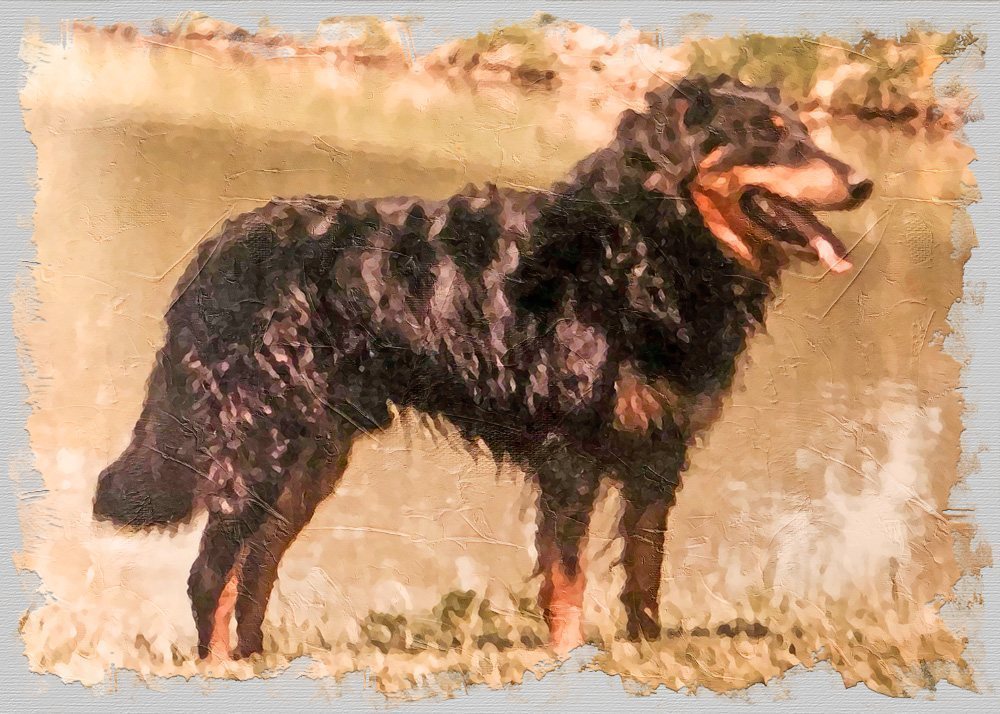The farmcollie movement influenced the English Shepherd breed community via internet lists, AWFA, and the vocalness of its proponents. Since this all coincided with the breed coming out of a pretty severe bottleneck, it skewed what was being bred and it influenced a lot of new breeders. So now, black and tans are in a relatively more precarious place than some of the other parts of the breed.
A recent conversation with a long-time breeder, present during the growth of the farm collie movement, recalled how the biases and stereotypes attached to black & tan lines influenced the breed community at a critical point in breed history. Here are some highlights of that conversation:
A.B.: What was it like when the farmcollie movement began to affect the English Shepherd world?
The stereotyping of black and tans by some of the farmcollie movement’s advocates during the early 2000s suggested that, as a group, black and tans were aggressive and unstable – “alligator dogs” that would eat up livestock. They would take traits that were historically valued in black & tan dogs, like toughness or grit, and re-define them; rather than “grit” signifying a dog with the courage to hold its ground, “grit” became synonymous with prone to biting and rough on stock. Stories were told, and repeated, and next thing you know one person’s bad experience with a black & tan dog characterized the entire bloodline. Some of the farmcollie folks seemed bent on discrediting dogs from lines other than those they valued. They would harp on the recklessness of crossing to those alligator dogs, with a boogeyman that you’d produce dogs that bite the grandkids or maul stock. Naturally that would make people wary!
A.B.: What has been the impact of the farmcollie movement on English Shepherd bloodlines?
The narrative from the farmcollie movement made “lines” (which were usually poorly defined) within the breed so different – ranging from gentle/nurturing/farmcollie to gritty/ alligator/ black&tan – that there was no common thread; crossing lines as a breeder meant rolling the dice because the attributes from one line to the next were opposites. Of course, there are differences between longstanding lines (note how few those are, though – one generation with a given breeder is not a “line”). The distinctiveness of various lines is great. They should also share the defining qualities of an ES, though, otherwise, what’s the point of labeling them English Shepherd?
A.B.: Can you speak to the English Shepherd breed’s diversity?
Often there is a misunderstanding of what is meant by valuing diversity in the breed; the diversity valued is in non-essential (not breed-defining) traits, diversity does not mean “anything goes”. A good English Shepherd should be a dog of solid character, capable of working stock, reliable with family members, loyal to their owner. It isn’t valuing diversity to brush aside those requirements. The “nurturing” dog that can’t move your stock or the “alligator” dog that kills your stock are both lacking essential qualities.
A.B.: In the English Shepherd breed, is Black and Tan just a coat color?
Color is not what defines an ES; character and abilities define the breed. And the black & tan color pattern is in various lines – so in that sense, black and tan is “just” a coat color. But color can *certainly* be a hallmark of a line, as was the case with some traditional black and tan lines. And different lines might be more suited to certain people/places/work. Sometimes the valued differences were just aesthetic (some breeders loved “ring neck” dogs; certain ranchers out west liked bobtail or docked tail dogs), sometimes the differences were in personality (more friendly, or more independent). Preserving distinct lines is valuable. But still there is a relationship between the lines – they share a broad history as an American breed with roots going back to Shepherd dogs from the UK; they are versatile farm dogs; and they are of similar type (size, coat, general features).
A.B.: What do you think about the Old-Fashioned Black and Tan English Shepherd Association?
I think the black and tans you are working on maintaining are a distinctive type. Some of the first ES I met were black and tans from the Oneys. The first English Shepherd website featured Kathy Lofthouse’s beautiful black & tan dog, Purdy, on the home page and she was the perfect dog to be the “face” of the breed. Those dogs had a certain natural dignity, discernment, and quiet confidence. To then a decade later see black and tans characterized as “alligators” (indiscriminately or inappropriately aggressive) dogs really bothered me. That description might fit some individual dogs, or some particular breeder’s dogs, but it did not fit my experience with the color. I think the work you are doing to preserve the black and tan lines is great. I think your strategy makes sense and covers the essential needs. I personally would not worry about a black and tan stud dog breeding to a non-black and tan female, since stud dogs can breed many times. It could be that down the road, some of those outcross breedings prove valuable for weaving in genetic diversity. I totally get not just offering a stud dog to all-comers, though, there is a responsibility that goes with offering a dog at stud and if the breeding won’t do anything to further your goals, what’s the point?
Featured photo is of Oney’s Butch

